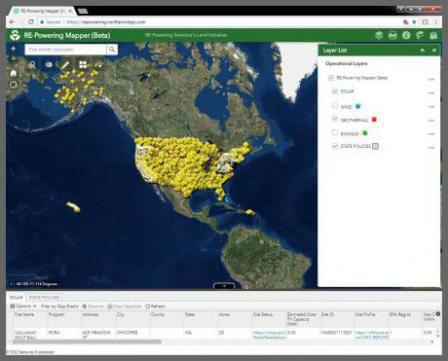The U.S. Environmental Protection Agency (EPA) is announcing updates to a mapping tool under its RE-Powering America’s Land Initiative, that aims to help communities, developers, and other stakeholders site renewable energy on current and formerly contaminated lands, landfills, and mine sites.

The EPA’s RE-Powering Mapper is an interactive web application that lets users visualize key information on renewable energy potential, such as for wind and solar projects.
In addition to providing a pollution-free source of energy, siting renewable energy projects on contaminated properties can have a number of environmental and economic benefits. Through reuse of these sites, communities see a property that had been vacant or underutilized for many years turned into a facility that may help improve the local tax base, create jobs, and turn blight into an economic opportunity.
“EPA is not only helping communities across the country clean up contaminated sites, but we are also helping them redevelop those sites for renewable energy production,” said EPA Acting Administrator Andrew Wheeler. “EPA’s updated RE-Powering Mapper is a valuable tool for the public to use in transforming hazardous sites into assets that can serve the community for years to come.”
EPA’s RE-Powering Mapper is an online interactive web application, that lets users visualize key information on renewable energy potential at specific contaminated lands, landfills and mine sites. Using screening criteria developed in collaboration with the National Renewable Energy Laboratory (NREL), EPA has pre-screened more than 130,000 sites for their renewable energy potential.
As part of this effort, EPA collaborated with state agencies from California, Colorado, Connecticut, Florida, Hawaii, Illinois, Maryland, Massachusetts, Minnesota, Missouri, New Jersey, New York, Oregon, Pennsylvania, Texas, Virginia, and West Virginia. The Mapper includes:
Mapper features include:
- Screening results for more than 130,000 sites for solar, wind, biomass, and geothermal energy.
- Search options for a number of site attributes including state, acreage, renewable energy capacity, distance to nearest urban center, and more.
- Site-specific screening reports.
- Links to EPA or state program managing the site clean-up.
In addition to the updated Mapper, EPA has recently released other resources to help encourage the development of renewable energy projects on contaminated and under-used properties. These include:
- New Training Module, which educates stakeholders about the various land use considerations for pursuing renewable energy projects on contaminated lands, landfills and mine sites.
- Topics include: site control and ownership; liability concerns; site clean-up status and timeline, and environmental permitting requirements.
- Fall 2018 Benefits Matrix, which summarizes more than 200 reported benefits associated with completed RE-Powering projects. Commonly reported benefits include revenues from land leases and taxes, electricity cost savings associated with the reduced need to purchase power from the grid, job creation, and reduced greenhouse gas emissions.
Background:
Potentially contaminated land, landfills, and mine sites can offer communities and developers significant advantages over other sites, such as open space, for renewable energy development. Some of these sites have unique attributes that can lower development costs and shorten development timeframes.
RE-Powering has facilitated redevelopment efforts to reuse abandoned industrial sites for wind farms and former landfills for solar arrays. These projects generate returns nationwide from Georgia to Massachusetts, New York to California.
Filed Under: News, Projects




